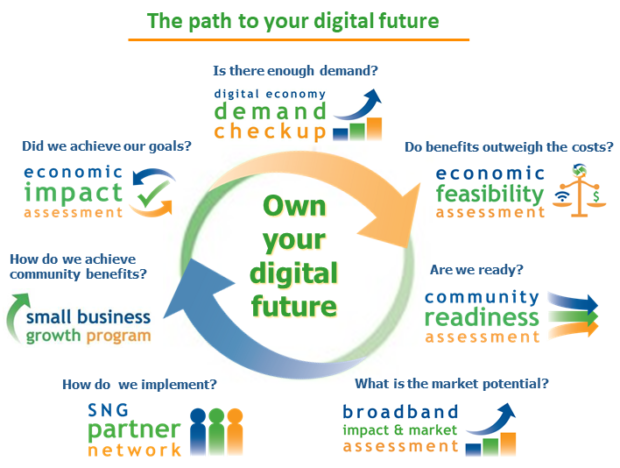Developing Policies and Plans That Help Communities
Effective broadband research empowers policies and initiatives that help communities … using empirical data to build buy-in.
Any agency at federal, state, and regional level that wants to assist communities and regions in addressing their digital infrastructure needs should start with empirical data on the current state of broadband availability and use.
While much time and effort has focused on broadband availability maps and network costs, this information is only half the story – at SNG we call this the supply side of broadband. When you look at broadband supply gaps in isolation, the costs to bridge those gaps can be prohibitive and this results in an under-investment in digital infrastructure.
The investment drivers for digital infrastructure are the expected returns from how broadband can be effectively leveraged for social benefits and economic growth. Ultimately it is what people can and will do with broadband that delivers the desired community benefits and economic impacts. At SNG we call this the demand side of broadband. Assessing community returns on broadband investment is essential and a holistic approach to investing in digital infrastructure and programming that may not need to raise taxes, nor take on unsustainable debt. The Ammon case example shows how community benefits outweigh the broadband investment costs.
Looking beyond broadband connectivity and its value to users, having unconstrained digital infrastructure enables communities large and small to make the transformation to smart communities with smart city services that improve community vitality and competitiveness while reducing municipal costs. Ubiquitous, quality broadband connectivity is a key underpinning for essential digital infrastructure.
“Michael Curri and SNG give quantifiable reasons to deploy broadband. Their research provides hard data that is specific to a community, region, or state, not opinions, feelings, assumptions, or conjecture. Finally we have access to facts that enable informed decisions so we can confidently define a path forward and acquire favorable financing.”
Joseph Franell
CEO – Eastern Oregon Telecom
Chair – Oregon Broadband Advisory Council
Informing policies and plans
Much effort has been devoted to addressing broadband availability issues, including establishing regulatory policies, strategic plans, or funding programs. While this is needed, much less attention has been typically given to ensuring that the full potential of broadband is realized by communities and regions. Understanding the current state of broadband use is the fundamental demand driver of broadband. See how the State of Tennessee assessed their current state of broadband availability and use.
Empirical data that benchmarks the needs and uses of broadband directly from citizens and businesses can build buy-in on which gaps and opportunities to focus. Time and money are limited, so an evidence-based approach is fundamental to more effectively targeting investments that address the needs of a community or region and help them achieve desired outcomes. Furthermore, a current state of broadband assessment establishes a benchmark and provides a reference base against which to measure impacts of policies and programs over time – at SNG we call this measuring the community return on investment.
“SNG’s Research and Report helped lay the foundation for the passage of the Broadband Accessibility Act to deregulate, invest, and educate to increase broadband access and adoption in Tennessee.”
Amanda Martin, Director
State of Tennessee Broadband Office
What do you need to know?
Through SNG’s research of best practices on broadband benchmarking around the globe, as well of our years of experience in conducting current state of broadband assessments, we have defined the right metrics to make the right decisions:
- Utilization – How citizens and businesses are currently using or plan to use broadband.
- Drivers – The importance of factors that motivate broadband utilization.
- Barriers – The importance of factors that inhibit or prevent effective broadband utilization.
- Benefits – The importance of broadband for creating positive impacts for users.
- Impacts – The quantification of benefits realized by businesses and households.
- Profile – Information about user characteristics and their Internet connectivity.
Armed with empirical data and an evidence-based approach to investing in digital infrastructure, agencies at a federal, state, and regional level can develop policies and programs and build buy-in around:
- Current state of broadband use by market segments (demographics, industries, etc.)
- Economic impacts already achieved from investing in broadband
- Potential economic benefits to be realized from increasing adoption and utilization
- Gaps and opportunities by sectors and locations
- Future broadband needs
- Need for awareness and adoption programs

Understanding both supply and demand for broadband is not only a more holistic approach, but also uncovers how to fund investments in infrastructure and programming.
Research current state of broadband uses and needs
Get a current state assessment of broadband uses, needs, gaps and opportunities for more effective policies and programs.
Learn how SNG’s eSolutions Benchmarking can deliver empirical data and essential analytics for effective broadband strategies.
Take a holistic approach
Assessing both demand and supply of broadband, provides a holistic approach to understanding community return on investment, broadband uses, needs, gaps and opportunities.
Learn about SNG’s unique Holistic Approach tailored to your broadband strategy to achieve your goals
